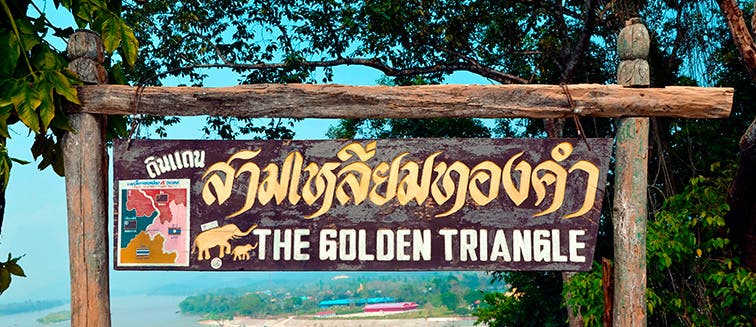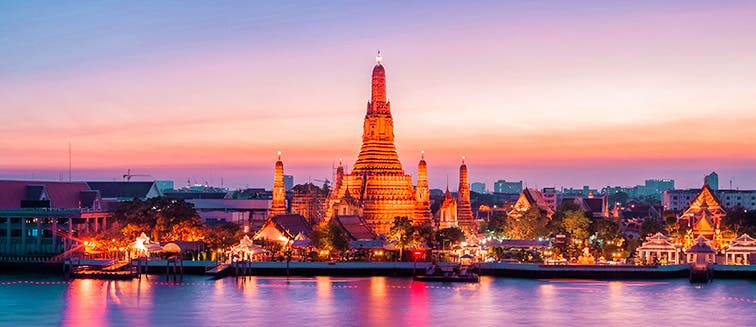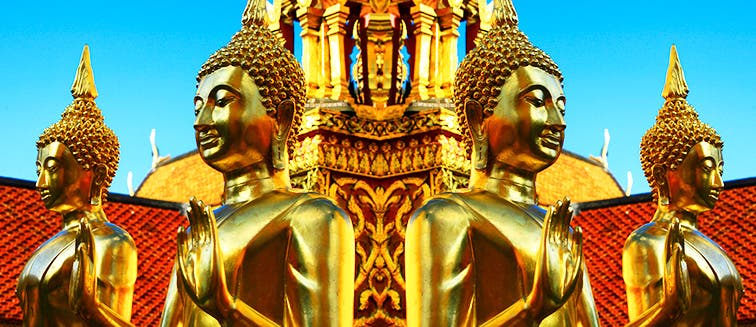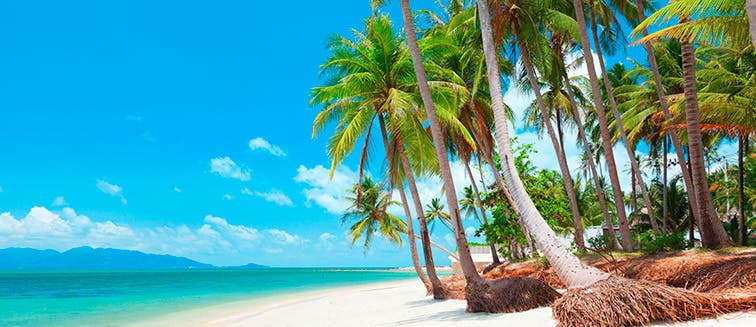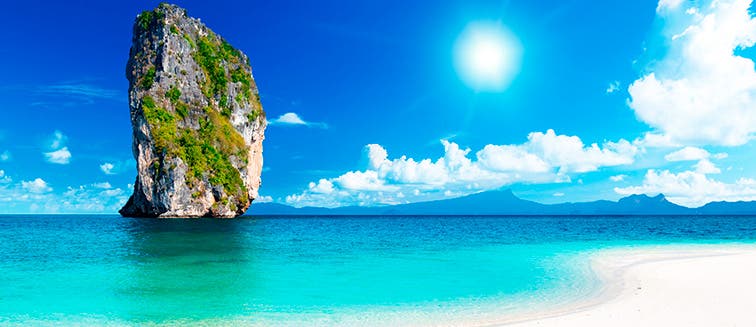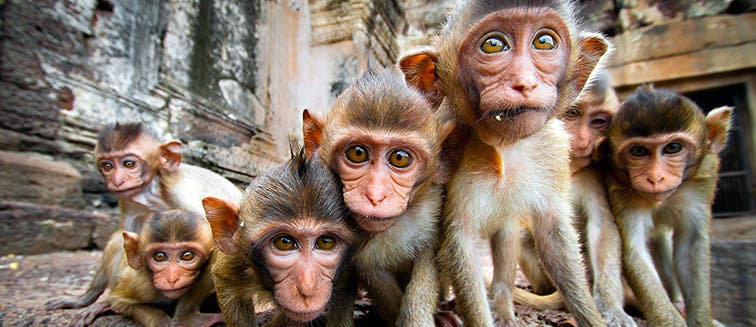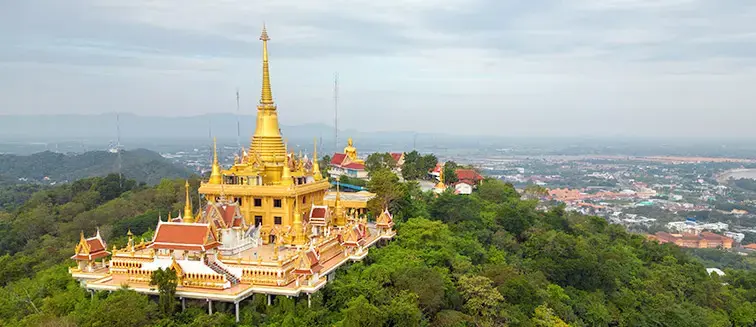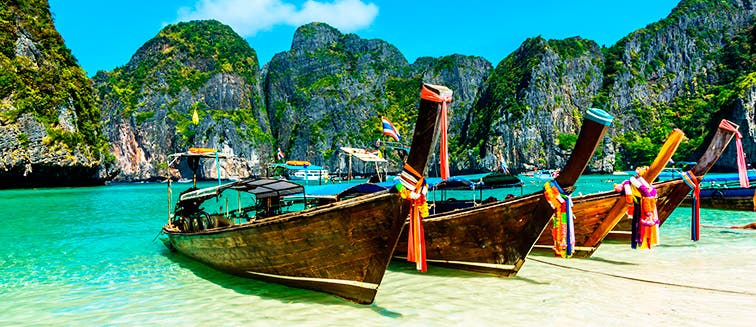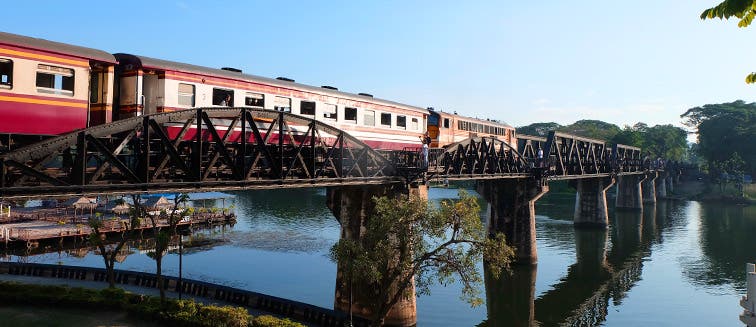Africa
Americas
Asia
Europe
Oceania
Holidays to Europe (94 available)
Albania(2)
Austria(6)
Baltic States(3)
Belgium(5)
Croatia(3)
Cyprus(1)
Czech Republic(5)
Denmark(1)
England(10)
Finland(2)
France(13)
Germany(7)
Greece(10)
Holland(5)
Hungary(4)
Iceland(6)
Ireland(9)
Italy(13)
Montenegro(1)
Northern Ireland(2)
Norway(9)
Portugal(10)
Romania(1)
Scotland(6)
Slovakia(1)
Spain(9)
Sweden(2)
Switzerland(4)
By Season
By Interest
By Group
Advisors hotline: +1 778-743-2337
Mon - Fri: 9am - 9pm EST
Saturday: 9am - 6pm EST
Sunday: Closed
What to see in Thailand
Golden Triangle
Tourist attractions Golden Triangle
Chiang Rai is the gateway to the famous Golden Triangle, the site of the powerful rivers Ruak and Mekong, which separate the borders between Thailand, Myanmar, and Laos. The most coveted photo can be captured at the point where the sign pointing to the town is located, and from where you can see a beautiful view of the vegetation, mountains and murky waters that divide the three countries and that the locals have given to calling Sop Ruak.
Approaching an indigenous village in the border area is an exciting experience that is often included on a package tour of Chiang Rai and that is always worthwhile.
Many ethnic groups arrived from southern China and Burma to Thailand in the late nineteenth and early twentieth centuries, fleeing from armed conflicts and persecution, which were often the result of illegal cultivation of opium, which led to the proliferation of drug mafias.
The Triangle became more famous during the Vietnam War, when opium trade and heroin consumption increased until King Rama IX, to end this scourge, founded the so-called "Real Project" in 1969. Through this initiative, he urged immigrants to join the culture and customs of the country replacing their crops with alternatives and focusing on organic produce. Thus, the lands were filled with plants, flowers, fruits, vegetables, rice, coffee and tea to which the Royal Seal of guarantee of the ecological quality product would be added, and would eventually produce a greater income than those of the opium.
The Opium Museum is an interactive room that brings visitors closer to the history of its cultivation and is focused on showing young people and adults, how it was a global problem and how drugs affect consumers and their families in a destructive way.
In the mountains, there are 7 ethnic groups and some of them are subdivided into others. Most are animists and continue to worship gods and spirits, although many of them are becoming Christianised. Each one has its own language, rites, religion and clothing and their means of subsistence is based on agriculture and, in recent years, also tourism.
There are the Lahu, Akha, and Lisu, with the same Tibetan-Burman linguistic root; the Hmong and Yao with a Sino-Tibetan language of origin and the Karen. The Lahu are divided into red yellow or black subgroups; the Akha are governed by rules that are based on respect for the older and more experienced individuals and women wear a colorful outfits decorated with beads, tassels, and ribbons; the Lisu live in bamboo and wooden houses and have sorcerers who interpret the future; the Hmong or Meo, among which their exit subgroups such as white and blue Hmong, settle at the top of the hills and practice a lot of Thai culture; the Yao or Mien profess Taoism and wear embroidered costumes, red necklaces, dark turbans with silver ornaments and jewellery; and the Karen, who live in the lowlands and are the most numerous with 400,000 members divided into subgroups with different languages. The famous ‘Giraffe Women’ do not belong to them but to the Karen Red or Karenni and they are a minority group from Mongolia that arrived in Burma and fled to Thailand in the 80s and 90s due to the civil war, becoming political refugees. Although there is a lot of literature that refers to tiger attacks and evasion of slavery, the real reason for the placement of necklaces on these women's neck is to feel attracted to men.
In Sop Ruak, you can board a canoe or speedboat for a pleasant walk upstream and visit the handicraft market on the island of Don Sao, which is part of Laos, followed by Chiang Saen, the oldest city in the country and once the capital of the Kingdom of Lanna, in the south of the Triangle. Here it is common among the locals to contemplate the sunsets over the Mekong with their families and to watch the birds on Lake Chiang Saen. Visitors can enjoy a stroll through the night market of Walking Street and visits to temples such as Wat Pasak, which is very beautiful and well preserved; Wat Phra That Chedi Luang, the largest stupa in the area; and the Wat Phra That Ngao, located outside the city walls and with a golden Buddha and a viewpoint from which there are spectacular views of the river and the mountains.
In the border region, in Mae Sai, the northernmost town in the country, the influx of tourists is scarce. Its major attractions, besides visiting the lively market, walking along the main avenue and crossing the bridge that spans the Sai River to the Burmese town of Tachileik, is to enjoy the temples and their great views. Among them, the Wat Phra That Doi Tung stands out, which is submerged in the dense vegetation on the top of Mount Doi Tung and has 2 chedis. At Wat Phra That Doi Wao or Temple of the Scorpion, there is an excellent viewpoint to admire the Triangle and the Thamphajoen Temple at the bottom of the hill.
The Golden Triangle is a mythical part of Thailand, a beautiful fluvial enclave that embraces three countries and that has played a pivotal part in the chronicles of the country's history. It is a landmarked by a past of opium cultivation but it is blessed with the best landscapes and the most pleasant people you can imagine.
OUR BEST TRIPS TO GOLDEN TRIANGLE
YOU ALSO LIKE
Cambodia
4 Trips
Indonesia
9 Trips
Laos
Notify me when available
Malaysia
2 Trips
Myanmar
Notify me when available
Philippines
2 Trips
Singapore
2 Trips
Thailand
6 Trips
Vietnam
7 Trips
Turkey
8 Trips
Jordan
6 Trips
Israel
Notify me when available
Armenia
Notify me when available
Uzbekistan
2 Trips
Oman
Notify me when available
Lebanon
Notify me when available
Kazakhstan
1 Trips
Kyrgyzstan
Notify me when available
Qatar
4 Trips
Bahrein
1 Trips
India
11 Trips
Bhutan
2 Trips
Nepal
5 Trips
Sri Lanka
6 Trips
Maldives
6 Trips
United Arab Emirates
3 Trips
Saudi Arabia
2 Trips
China
3 Trips
Japan
9 Trips
Hong Kong
1 Trips
South Korea
6 Trips
Tibet
Notify me when available
Mongolia
Notify me when available
Taiwan
Notify me when available
Tourist attractions thailand
Points of interests
- Trips to Ayutthaya
- Trips to Bangkok
- Trips to Chiang Mai
- Trips to Chiang Rai
- Trips to Golden Triangle
- Trips to Koh Samui
- Trips to Krabi
- Trips to Lopburi
- Trips to Nakhon Sawan
- Trips to Phi Phi
- Trips to Phitsanulok
- Trips to Phuket
- Trips to River Kwai
- Trips to Sukhotai
Other Points of interests
- Trips to 4000 Islands
- Trips to Amarapura
- Trips to Angkor Wat
- Trips to Bagan
- Trips to Bako National Park
- Trips to Bali
- Trips to Banaue
- Trips to Batu Caves
- Trips to Benoa
- Trips to Boracay
- Trips to Candidasa
- Trips to Cebu
- Trips to Chinatown
- Trips to Chocolate Hills
- Trips to Clarke Quay
- Trips to Coron
- Trips to Cu Chi Tunnels
- Trips to Damai Beach
- Trips to Danang
- Trips to El Nido
- Trips to Flores Island
- Trips to Gardens by the Bay
- Trips to Gili Air
- Trips to Gili Trawangan
- Trips to Halong Bay
- Trips to Hanoi
- Trips to Ho Chi Minh
- Trips to Hoi An
- Trips to Hue
- Trips to Inle Lake
- Trips to Jakarta
- Trips to Java
- Trips to Komodo Island
- Trips to Kong Lor Caves
- Trips to Kuala Lumpur
- Trips to Kuching
- Trips to Kuta
- Trips to Labuan Bajo
- Trips to Lang Co Beach
- Trips to Langkawi
- Trips to Little India
- Trips to Lombok
- Trips to Luang Prabang
- Trips to Malaca
- Trips to Malapascua
- Trips to Mandalay
- Trips to Manila
- Trips to Marina Bay Sands
- Trips to Mayon Volcano
- Trips to Mekong Delta
- Trips to Merlion Park
- Trips to Mui Ne
- Trips to Nusa Penida
- Trips to Orchard Road
- Trips to Papua
- Trips to Paso Hai Van
- Trips to Phnom Penh
- Trips to Phú Quốc
- Trips to Puerto Princesa
- Trips to Raffles Hotel
- Trips to Sagaing
- Trips to Sapa
- Trips to Senggigi
- Trips to Sentosa
- Trips to Siem Reap
- Trips to Sihanoukville
- Trips to Singapore
- Trips to Subterranean River National Park
- Trips to Sulawesi
- Trips to Sumatra
- Trips to Sunda Islands
- Trips to Tam Coc
- Trips to Ubud
- Trips to Yangon
- Trips to Yogyakarta
Countries Nearby
- Armenia Trips
- Bahrein Trips
- Bhutan Trips
- Cambodia Trips
- China Trips
- Hong Kong Trips
- India Trips
- Indonesia Trips
- Israel Trips
- Japan Trips
- Jordan Trips
- Kazakhstan Trips
- Kyrgyzstan Trips
- Laos Trips
- Lebanon Trips
- Malaysia Trips
- Maldives Trips
- Mongolia Trips
- Myanmar Trips
- Nepal Trips
- Oman Trips
- Philippines Trips
- Qatar Trips
- Saudi Arabia Trips
- Singapore Trips
- South Korea Trips
- Sri Lanka Trips
- Taiwan Trips
- Thailand Trips
- Tibet Trips
- Turkey Trips
- United Arab Emirates Trips
- Uzbekistan Trips
- Vietnam Trips
Trip Styles
